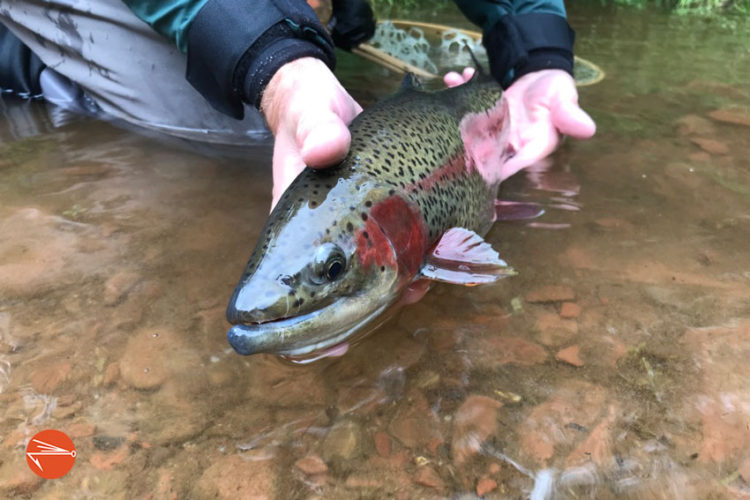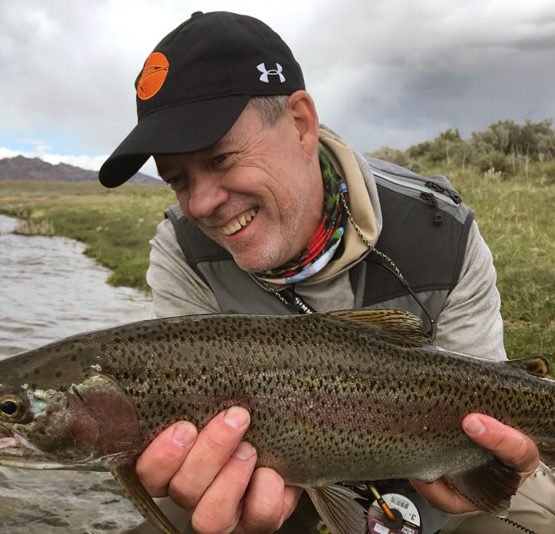If you’re an angler wanting to know more about what trout eat, you’ll love this post.
Assuming you’ve taken up fly fishing, it’s probable that the further into it you’ve gotten, the more overwhelmed you’ve become with the limitless amount of things there are to learn. From various kinds of fly fishing to the myriad types of equipment; from the varieties of fly fishing environments and conditions, to all there is to know about imitation flies and how to present them to fish, it’s daunting. Add to that, if you want to be better at catching trout by imitating what they’re eating, it would be helpful to know just that. Therefore, one of the essential questions every fly fisher must ask is: what do trout eat?
In general, trout eat a protein-rich diet of aquatic-born insects and annelids. However, they are also known to eat everything from flies, worms, terrestrials, and leeches, to various types of crustaceans, minnows, frogs, and even small rodents, such as mice.
Simply put, if you can determine what they’re eating and match it with your presentation, your success as a fly fisher will soar.
With that exciting outcome in mind, this post outlines the primary food groups on which trout are known to feast. Within each category, we offer a few suggested fly patterns that we consider our go-to trout enticers.
#1: Aquatic-born Insects
With just a few exceptions (that I can’t even think of right now), the term “aquatic-born insects” is a snooty way we hoity-toity fly fishers refer to these things most of the public calls flies. Yep, just flies. And when we actually say, flies, we generally don’t mean the common housefly. We mean all the bazillion other kinds of flies that begin their life-cycle in a body of fishable water or, put another way: fish food.
As common and plentiful as anything on earth, aquatic-born flies are vulnerable to feeding trout at just about every one of their short life stages. Because we readily see them feeding on surface flies, we sometimes forget that the bulk of a trout’s fly diet is composed of underwater fare, or, the pre-adult stages of an aquatic-born fly’s life cycle.
Broadly referred to in fly fisher’s parlance as “nymphs,” imitation flies that mimic a fly’s pupal, larval and emergence stages should occupy a large percentage of your fly box.
And since a trout’s diet is so heavily made up of these subsurface edibles, learning how to fly fish with nymphs will keep you from having slow days when fly hatches are infrequent or brief.
After an aquatic-born fly has served its time under water, it emerges from its nymphal shuck (hatches), rests on the surface to dry its brand new wings, then takes off to mate, lay its eggs and, well, fall back to the water and die.
Some life, huh?
Imitation fly patterns that impersonate these surface stages are generally referred to as “dry flies” but come in different forms to mimic the wing-drying adult (“dun”) and dying (“spinner”) phases.
Thus, dry fly patterns in different types, colors and sizes, should also comprise a good portion of your fly box.
And to put an emotional point on this paragraph, when trout are feeding on dry flies, and when you, the fly fisher, have “matched the hatch,” the fun you’ll have during that often brief stretch of time will cement both your love of the sport in your heart and that goofy grin on your face.
Recommended Nymph Patterns: RS2, Prince Nymph, Flashback Pheasant Tail, Golden Stonefly, Barr’s Emerger, any Baetis Pattern, Caddis Pupa, Rainbow Warrior
Recommended Dry Fly Patterns: Parachute Adams, Blue-Winged Olive (BWO), Pale Morning Dun (PMD), Caddis, Drake, Yellow Sally, Trico (Dun and Spinner).
#2: Terrestrial Bugs
In the heading of this paragraph, I was tempted to write “Terrestrial Insects” but I went with “bugs” because, while most of these land-born critters are true insects — grasshoppers, ants and crickets — some of them fall into other categories such as arachnids, a.k.a spiders, mites and ticks.
The long and short of it, if you’ve ever watched what happens to a land-dwelling bug that has accidentally found itself struggling to escape a trout-inhabited body of water, it’s quite clear that said trout don’t often pass up the opportunity to devour one.
Indeed, among the things about trout that I marvel at is that, though not often considered in this light, they are fierce, voracious predators that, much like their ocean-dwelling shark cousins, rarely take off the feed bag.
So, when trout spy a big, tasty, protein-rich meal flopping around overhead, they usually attack it with shark-like ferocity.
Therefore, a well-prepared angler will stock a hearty selection of terrestrial patterns in their fly box. Incidentally, over the years, terrestrial imitations have become more and more lifelike, which, ironically, makes them as attractive to the fly buyer as they are to the trout he or she is hoping to catch.
Recommended Terrestrial Patterns: Parachute Hopper, Flying Black Ant (black, red, or cinnamon), Madam X, Amy’s Ant, Cricket, Stimulator (just about any color), Dave’s Hopper, Foam Beetle, and anything with Chernobyl in its name.
#3: Annelids: Worms & Leeches
I’m not a marine dietician (is that even a thing?), but, when it comes to trout, it’s safe to say that they are more Keto than anyone you’ve ever known. Oh, of course, just like anyone would when nobody’s looking, they probably slip in a doughnut now and then, but when your day consists of swimming against a stiff, cold current and beating your elders and friends to the next morsel of food, you’re surely going work up a solid jones for high-octane protein.
Enter trout-fave annelids: worms and leeches; each a solid dose of pure protein straight out of the Bear Grylls survival handbook.
Typically fished as nymphs and streamers, respectively, worm and leech patterns tend to draw subsurface hits that provide the angler with dramatic, can’t-miss strike indicator movement or jarring streamer attacks that, even with a slow set, turn into well-hooked trout and fun rides to the net. You’re welcome.
Recommended Worms & Leech Patterns: San Juan Worm, Micro Worm, Egg-Sucking Leech, Wooly Bugger, Span Juan Worm, Red Wire Worm, Conehead Bite Me Bugger
#4: Crustaceans
Although this group of arthropods includes king crab and lobsters, when you consider crustaceans in the world of trout, think scuds, snails, mysis shrimp and crayfish.
These exoskeletal critters are protein-rich and prevalent in still waters, rivers, and small streams. They are, therefore, a top-of-the-list selection on any trout’s menu.
Also fished as nymphs, crustaceans make a great lead fly on a double or triple-bug rig.
And any time you find yourself fishing just below the outlet of a dammed reservoir or lake, throw on a mysis shrimp pattern and expect fireworks.
Some of the biggest trout you’ll ever have on the line sit in these deep, dark outlet zones and feed on mysis shrimp as if they were Jabba the Hutt himself.
Please pass the cocktail sauce and lemon wedge!
By the way, if you should ever have the chance to fish one of these stretches of river with mysis at night, JUMP ON THE OPPORTUNITY! Zach and I have experienced a few such episodes fishing the famed “Hog Trough” of Colorado’s Taylor River at night. Let’s just say that to describe them as epic and indelibly memorable would be a wild understatement.
Recommended Crustacean Patterns: Standard Scud (olive, orange, tan, pink… whatever), Pete’s Carpet Scud, Ray Charles (gray, pink, tan), Pink Sow Bug (with or without a fire bead), Mysis Shrimp.
#5: Minnows and Eggs
Never let it be said that trout don’t eat their young because, well, they do. I told you they were vicious predators!
Minnows of many varieties can usually be found clustered in shallow riverside pockets where larger meal-marauders can’t easily get to them. There, they do their best to eat without being eaten and, in so doing, get larger, faster, and less edible.
But woe to them if they wander or get flushed out of the playpen because their ravenous trout superiors will, literally, make a meal out of ‘em.
To make matters worse for our imperiled finned youngins, trout gulp their still egg-bound kin with a smile on their faces. In fact, during the spawning season, trout will gather at the bottom of a series of “reds” — riverbed fields where, during spawning season, trout hens attend their eggs — to feast on wayward ones that dribble out of their nests. Considering this kind of behavior, it’s a wonder that any of them become adult trout in the first place.
Talk about your dark underworld!
Recommended Minnow and Egg Patterns: Thin Mint, Clouser Minnow, standard egg patterns in orange and yellow variations.
#6: Small Rodents And Amphibians
When it comes to their diets, trout are not unlike many other creatures; we all enjoy a walk on the culinary exotic side every once in a while.
Take us humans for instance. Don’t we all like an occasional departure from the typical weeknight fare? Not sure I’m down with super weird stuff, but a Chimichanga or a plate full of Kung Pau is usually a welcome departure.
Even sharks will skip over the standard shark fare to chow a small skiff now and again.
Why should trout be any different?They certainly love a bust-your-belt feast just as much as the next guy.
In Troutville, the most common among these would have to be tadpoles, frogs, toads, mice, and variations thereof.
I confess that I don’t have a lot of experience fly fishing with patterns that imitate such beings, but skate a mouse pattern through a run where occurrences of accidental mice-fall-into-the-river situations are common, and you might just draw a giant trout strike that’ll make you wet yourself.
Just as enticing, frog-like amphibians also occupy a prominent spot on a trout’s dietary must-eat list. Since such imitations are more prevalent in the spin-caster’s world, there is a greater variety of frog-ish lures to be found there. However, amphibian-style “flies” can be found in most fly shops where trout are known to eat them, and buying such flies local to the body of water you intend to fish is always a good idea.
Another good idea is to keep a special fly box wherein you keep your selection of mouse and frog patterns. And since such imitations tend to be well tied and, thus, hold up over time, your collection will grow with each addition.
Recommended Mouse and Amphibian Patterns: Betts Frugal Frog, Morrish Mouse, Mini Mouse (really guys?), Mr. Hankey, Mouserat Fly
You Might Also Like:
- 12 Killer Foam Flies You Need To Try
- 15 Best Flies For Cheesman Canyon
- What Are Parachute Flies? (Plus 5 Great Examples)
- 21 Best Flies For The Bighorn River
- Fly Fishing With Small Flies (The Complete Guide)
One Last Bite
Again, I remind you that, while I know a fair amount about a trout’s diet, I am not a marine dietician. So, while I suspect that trout ingest some floating greens in their never-ending pursuit of sustenance, make no mistake, they are highly-skilled predatory meat-eaters with a wide variety of tastes and options, none of which fall into the salad category.
And with that, I hope this post has opened your eyes to how wondrous these trout creatures really are and how exciting it will be for you as an insatiably enthusiastic angler to explore the different fishing techniques and presentations their common food groups require.
Now excuse me while I go annihilate a plate of cocktail shrimp and a Chimichanga.
Tight Lines!
Disclaimer: This post may contain affiliate links, meaning we will receive a small commission (at no cost to you) if you click through and make a purchase.









